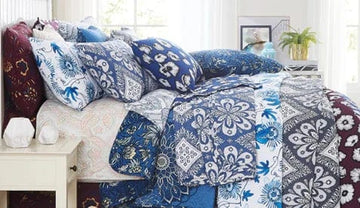7 Tips for Choosing Bedroom Colors
The color you choose for your bedroom should reflect your personality and tastes and create the mood you want in the room.
However, all too often, the number of paint choices can seem overwhelming. While there are no hard-and-fast rules, these tips can help simplify the process.
Whose Bedroom?
Consider whether you're choosing paint for your bedroom, a child, or a guest. The age of the occupant and the use of the room are important.
Neutral shades may be popular, but they’re not very exciting. If you want to add vibrancy or warmth to a bedroom, don’t ignore color. Even if you only paint an accent wall above the bed’s headboard, it can add interest. Besides, it’s only paint, and if you tire of it, paint it again down the road.
Consider the Mood
Color creates an emotional reaction. It can either calm or invigorate and make a room feel light and airy, or dark and cozy.
For instance, rich reds and warm browns create romance and comfort. Gold tones feel luxurious and yellows and oranges feel cheery.
Bright reds, oranges, greens, and blues aren’t typical colors for an adult’s bedroom, but they can work well in an energetic child’s room. Purple is a favorite in a youth’s bedroom as it stimulates brain activity and encourages study.
Most adults want a calming bedroom so they can unwind after their busy days. If you’re unsure of what colors work well together, consider using a color wheel. Colors next to each other on the color wheel (analogous) create a tranquil feel. For example, blue and green sit next to each other and work well together. Neutral gray is also a calming color that pairs well with pastels and bright colors.
Lighter paint colors can help a small room feel larger. Dark colors make a space feel smaller and cozier.
Use a Tried & True Color Palette
If you have no idea where to start, search for bedroom color schemes. You can immediately “see” designer color combinations to discover what you like, and what you would never consider in your bedroom.
While you don’t necessarily need to precisely copy the scheme, they’ll help you envision the colors with your furniture and they’ll narrow your choices.
Once you’ve found something that appeals to you, visit the paint store and pick up some paint chips. Look at them at different times throughout the day, because colors change in the morning, afternoon, and evening light.
Reverse Engineer
A simple way to choose a paint color is to choose bedding that you love first and then choose paint colors to coordinate with it. For instance, this Global Patchwork Reversible Duvet Cover Set includes dark and light blue and white in the pattern.

You could easily choose a lighter tone of the blue or paint a feature wall in the navy or bright blue dark tone. Gray would also work well with this print, as well as warm white.
Another example is the Infinity Reversible Duvet Cover and Sham Set. Its primary colors are light blue, navy, gold, and white. This bedding would look stunning with a shimmering light gold paint or a wash of pale blue on the walls. Add drama with a navy feature wall.
60-30-10 Rule
Apply color wisely in the bedroom. Decorators suggest following the 60-30-10 rule for balance and interest.
The walls should include the dominate color (60 percent), followed by the secondary color you choose in your upholstery or bedding (30 percent).
Lastly, 10 percent of the color in the bedroom should be in your accessories as accents. This could include pillows, ornaments, art, or whatever you choose to create a distinct bedroom statement.
Top to Bottom - Light to Dark
A risk-free way to decorate with color is to keep dark colors on the floor, medium color values on the walls, and light values on the ceiling.
Generally, rooms mimic the great outdoors where the earth is under our feet, trees and shrubs surround us, and the sky is above.

Look to Your Personal Preferences
A quick way to narrow your bedroom color choices is to look to your wardrobe. The colors that flatter you will make you feel good in your bedroom too.
This doesn’t mean you need to paint your bedroom denim blue if you like to wear jeans, but you can use the color in upholstery or accessories. If you like textures or patterns choose one what you like in your bedding and then embellish.
After all, the point is your bedroom should make you feel good, so create what works for you.



